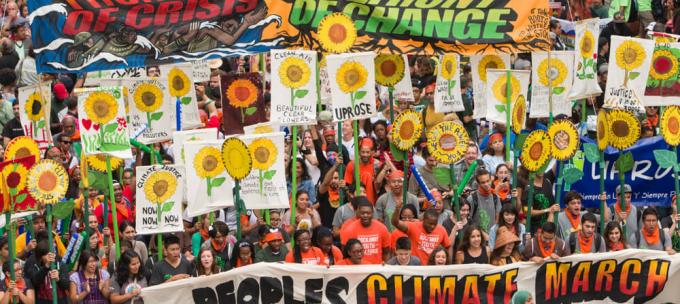
Photo courtesy 350.org/Robert van Waarden.

Photo courtesy 350.org/Robert van Waarden.
With the goal of furthering international agreements, the Fund made grants throughout the 1990s and early 2000s to groups coordinating the activities of NGOs that monitor and participate in UN climate negotiations, including: the Stockholm Environmental Institute (which had absorbed 1980s grantee The Beijer Institute); The Climate Institute; Climate Action Network-Southeast Asia; the Environmental Defense Fund; and the Natural Resources Defense Council.
After the 1995 Berlin meeting of signatories to the climate change convention, the Fund convened a meeting at Pocantico to discuss education and outreach strategies for communicating climate science in the period leading up to the 1997 Kyoto meeting, and subsequently it funded the National Environmental Trust, the Environmental Information Center, U.S. Climate Action Network, the Union for Concerned Scientists, and Environmental Media Services in efforts to expand the U.S. constituency for climate protection. These grantees launched high-level media campaigns using national newspapers, television, and radio, as well as national tours by prominent experts, geared toward reaching an audience of influential decision-makers, business leaders, and concerned citizens. The 1997 summit turned out to be an enormous setback, however, when the U.S. rejected its recommendations, and from this point forward the Fund sought to achieve impact on other levels, moving toward focusing on local and state measures, and re-examining the reach and tactics of grassroots movement-building. With the rise of the Internet and social media, effective campaigns have become less dependent on traditional media formats and the Fund’s grantees quickly adapted.
A second objective in the 1990s was the direct reduction of greenhouse gas emissions, and the Fund supported a wide range of activities related to energy efficiency, renewable energy, transportation, and tax reform. A large cluster of grants went to organizations developing model utility-based energy conservation programs, including to the Conservation Law Foundation, the Foundation for International Environmental Law and Development, the Institute for Strategic Evaluation for Energy and Environment in Europe, the International Institute for Energy Conservation, the Center for Clean Air Policy, the Resources Development Foundation, and the Southern Environmental Law Center. Many of these grants emphasized the transfer of successful models developed on both coasts in the United States to other U.S. regions, Europe, and Asia.
For a brief period, the Fund actively worked in promoting mass transit alternatives to automobile use and attempted to reform national transportation policy with grants to the Institute for Transportation and Development Policy, Friends of the Earth, and the Surface Transportation Policy Project. It also awarded grants supporting research on alternative tax structures that discourage use of fossil fuels, part of its efforts to build the business case for a clean energy economy.
The Fund also worked to encourage model renewable energy programs. It made grants to the Land and Water Fund of the Rockies and the Solar Electric Light Fund to encourage renewable energy projects and promote the spread of solar electrification systems in China, India, and Vietnam. These were regions where billions of rural people live without but wish to acquire electrification, which would be environmentally disastrous if accomplished through coal and oil.
Over the years, the RBF has been instrumental to the establishment of more than 40 environmental NGOs across the fields of biodiversity protection, conservation, and climate change.